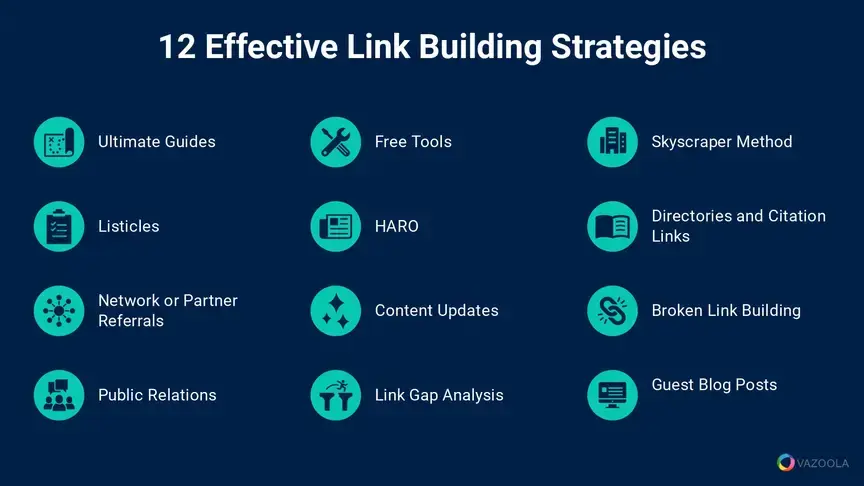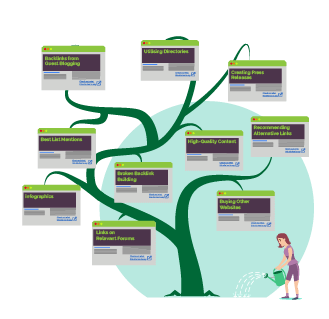Backlink strategies are essential for improving your website’s search engine ranking. They help drive traffic and boost online visibility.
In the competitive world of digital marketing, backlinks play a crucial role. They serve as votes of confidence from one site to another. These links not only increase traffic but also enhance your site’s authority. Effective backlink strategies can make a significant difference.
But not all backlinks are created equal. Quality over quantity is the key. Understanding the right tactics can set you apart. In this blog, we will explore various proven backlink strategies. These techniques can help you build a robust online presence. Stay tuned to learn how to effectively leverage backlinks. Your website’s success depends on it.
Table of Contents
ToggleIntroduction To Backlinks
Backlinks are links from one website to another. They are also called inbound links. These links are important for search engine optimization (SEO). Backlinks show search engines that your site is trusted and valuable.
In this post, we will explain the importance of backlinks and how they impact SEO. Understanding these concepts will help you improve your website’s ranking.
Importance Of Backlinks
Backlinks act as votes of confidence for your website. They indicate that other websites find your content useful. This can help your site rank higher in search engine results pages (SERPs).
Here are some key reasons why backlinks are important:
- Increase referral traffic: Visitors from other sites can click on your backlinks.
- Boost credibility: Links from reputable sites improve your site’s trustworthiness.
- Enhance discoverability: Search engines find your site through backlinks.
How Backlinks Impact Seo
Backlinks play a significant role in SEO. Search engines like Google use backlinks to determine the relevance and authority of your site. More quality backlinks can lead to better rankings. Here are some ways backlinks impact SEO:
- Page Rank: Backlinks help increase your site’s Page Rank, which is a measure of its importance.
- Crawling and Indexing: Search engines use backlinks to discover new pages and index them.
- Keyword Rankings: Relevant backlinks can improve your rankings for specific keywords.
It is important to focus on getting quality backlinks. Links from authoritative sites carry more weight. Avoid spammy or low-quality links. These can hurt your SEO efforts.

Credit: www.linkedin.com
Types Of Backlinks
Understanding the different types of backlinks is crucial for building a strong SEO strategy. Each type of backlink holds different value and can impact your site’s authority and ranking in various ways. This section will explore the primary types of backlinks, diving into their characteristics and benefits.
Dofollow Vs Nofollow
DoFollow backlinks are the most valuable type of backlinks for SEO. They pass on link juice, which helps improve your site’s ranking. Search engines recognize these links as a vote of confidence from one site to another.
On the other hand, NoFollow backlinks do not pass on link juice. They tell search engines not to follow the link, thus not contributing directly to your site’s ranking. NoFollow links are still valuable for generating traffic and building brand awareness.
| DoFollow | NoFollow |
|---|---|
| Pass link juice | Do not pass link juice |
| Improves SEO ranking | Does not improve SEO ranking |
| Recognized by search engines | Seen as a reference only |
Editorial Vs Non-editorial
Editorial backlinks are natural links given by other websites. They usually occur when your content is valuable and relevant. These links are highly regarded by search engines and significantly boost your site’s credibility.
Non-Editorial backlinks are often acquired through guest posts, directory submissions, or paid links. While they can still be beneficial, they do not carry the same weight as editorial links. Search engines might view them as less trustworthy.
- Editorial Backlinks: Natural, valuable, and trusted by search engines.
- Non-Editorial Backlinks: Often self-created, less trusted, but still useful.
Both types of backlinks have their place in a balanced SEO strategy. Focus on acquiring a mix of both to maintain a healthy link profile.
Creating Quality Content
Creating quality content is essential for effective backlink strategies. Quality content attracts natural backlinks, improves your website’s SEO, and drives traffic. The following sections will discuss how to create content that attracts links and which content formats perform best.
Content That Attracts Links
Content that attracts links must be useful and relevant. Here are some key points to consider:
- Research and data-driven content: Provide valuable insights and statistics.
- How-to guides and tutorials: Offer step-by-step instructions.
- Case studies: Share real-world examples and results.
- Expert roundups: Feature opinions from industry leaders.
- List posts: Organize information in easy-to-read lists.
Content Formats That Perform Best
Different content formats can attract more backlinks. Here are some formats that perform best:
- Infographics: Visual content is highly shareable and linkable.
- Videos: Engaging video content can attract a lot of links.
- Long-form articles: In-depth content provides more value and attracts more backlinks.
- Interactive content: Quizzes and calculators engage users and encourage sharing.
- Podcasts: Audio content can reach a different audience and attract unique backlinks.
By focusing on creating quality content, you can attract natural backlinks. This will boost your website’s SEO and drive more traffic. Remember to keep your content useful, relevant, and engaging.
Guest Blogging
Guest blogging is a powerful way to build backlinks. It helps in boosting your website’s SEO. By writing on other sites, you expose your content to a new audience. This increases your visibility and credibility.
Finding Opportunities
First, find blogs in your niche. Use search queries like “write for us” or “guest post guidelines”. Look for blogs with high domain authority. Check their engagement levels. Are there comments and social shares? This shows the blog has an active audience. You can also use tools like Ahrefs and SEMrush. These tools help in finding potential guest blogging sites.
Another way is to check competitors’ backlinks. Find out where they are guest posting. This can give you a list of quality sites to target. Networking is also key. Connect with other bloggers in your industry. Join blogging communities and forums.
Crafting Effective Pitches
Writing an effective pitch is crucial. Start with a personalized greeting. Mention the blog’s name and the editor’s name if possible. Show that you have read their content. Mention a specific post you liked. This shows you are not sending a generic email.
In your pitch, introduce yourself briefly. Mention your expertise and why you are a good fit. Propose a few topics that would interest their audience. Make sure these topics are relevant to their blog. Include links to your previous work. This gives them a sense of your writing style and quality.
Keep your pitch short and to the point. Editors receive many pitches. A concise, well-structured pitch stands out. Follow up if you don’t hear back. Be polite and patient. Persistence can pay off.
Building Relationships
Building relationships is a vital part of effective backlink strategies. It involves connecting with others in your niche to create authentic and valuable links. This method not only boosts your SEO but also fosters community and collaboration.
Networking With Influencers
Networking with influencers can significantly boost your backlink profile. Influencers have large followings and can provide high-quality backlinks.
Here are some ways to connect with influencers:
- Follow them on social media: Engage with their posts and share their content.
- Comment on their blog posts: Leave thoughtful comments that add value.
- Attend industry events: Meet them in person at conferences and webinars.
- Collaborate on content: Propose guest posts, interviews, or joint projects.
Engaging With Your Audience
Engaging with your audience helps build trust and encourages them to link back to your content. Interaction fosters loyalty and community.
Consider these strategies to engage your audience:
- Respond to comments: Answer questions and acknowledge feedback on your blog and social media.
- Create interactive content: Use polls, quizzes, and surveys to involve your audience.
- Offer valuable content: Provide tutorials, guides, and resources that solve problems.
- Host webinars and live sessions: Engage directly with your audience in real-time.
Building relationships through networking and engagement can significantly enhance your backlink strategy. Focus on genuine connections and providing value to your audience.
Utilizing Social Media
Utilizing social media for backlink strategies can be a powerful tool. Social platforms offer a wide audience and multiple ways to share content. By leveraging social media, you can build valuable backlinks that enhance your website’s SEO. Let’s explore some effective ways to use social media for backlink strategies.
Sharing Content
Sharing your content on social media can drive traffic and build backlinks. Create engaging posts that link back to your website or blog. Use eye-catching images and compelling headlines to attract attention. Here are some tips for sharing content:
- Post regularly to keep your audience engaged.
- Use relevant hashtags to reach a broader audience.
- Encourage sharing by asking questions or starting discussions.
- Promote new blog posts with a short summary and a link.
Joining Relevant Groups
Joining groups on social media platforms can help you reach a targeted audience. Participate in discussions and share your expertise. Here are some benefits of joining relevant groups:
| Benefit | Description |
|---|---|
| Targeted Audience | Groups are filled with people interested in your niche. |
| Networking Opportunities | Connect with influencers and potential collaborators. |
| Increased Visibility | Share your content with an engaged audience. |
Engage with group members by answering questions and providing valuable insights. Share your content when it adds value to the discussion. This can lead to more backlinks and increased traffic to your website.
Broken Link Building
Broken Link Building is a powerful SEO strategy. It involves finding broken links on other websites. Then you suggest replacing them with your own content. This helps improve your site’s authority and traffic.
Identifying Broken Links
First, you need to find broken links. Use tools like Ahrefs or SEMrush. These tools scan websites for broken links.
Another method is to check resource pages in your niche. Resource pages often have many links. Some of them might be broken.
Make a list of these broken links. Note the URL of the page with the broken link. Also, note the URL that is broken.
Outreach Strategies
Next, contact the website owner. Let them know about the broken link. Be polite and helpful. Offer your content as a replacement.
Here’s a simple template:
Hi [Name],
I was browsing your site and found a broken link on [Page URL].
The link to [Broken URL] is not working.
I have a similar resource that might help your readers: [Your URL].
Hope this helps!
Best,
[Your Name]
Follow up if you don’t get a response. Persistence pays off.
Remember, your content should be valuable and relevant. This increases the chance of getting your link added.

Credit: www.vazoola.com
Monitoring And Analyzing Backlinks
Backlinks are crucial for SEO success. Monitoring and analyzing them can help you understand your link-building efforts. It can also help you spot opportunities for improvement. In this section, we will explore how to effectively monitor and analyze backlinks.
Using Seo Tools
SEO tools are essential for tracking backlinks. They provide valuable insights into your backlink profile. Popular tools include Ahrefs, SEMrush, and Moz.
| Tool | Features |
|---|---|
| Ahrefs | Comprehensive backlink analysis, competitor research, and rank tracking. |
| SEMrush | Detailed backlink audit, link-building ideas, and domain comparison. |
| Moz | Link explorer, spam score, and anchor text analysis. |
Use these tools to get a complete view of your backlinks. Ensure you check the following metrics:
- Number of backlinks
- Referring domains
- Anchor text
- Link quality
Interpreting Data
Interpreting the data from SEO tools is the next step. Focus on the quality and relevance of backlinks. This helps you determine their impact on your SEO.
Here are some key points to consider:
- High-quality backlinks from reputable sites.
- Low-quality backlinks from spammy or irrelevant sites.
- Anchor text should be varied and natural.
- Referring domains should be diverse.
Analyze the data to identify patterns. Look for trends in your backlink profile. This can help you make informed decisions about your link-building strategy.
Monitoring and analyzing backlinks is an ongoing process. Regularly review your backlink profile. This will help you stay ahead in the competitive SEO landscape.
Avoiding Common Pitfalls
Building backlinks is crucial for SEO success. Yet, many fall into traps that harm their site’s ranking. By understanding common pitfalls, you can avoid these mistakes. This section will guide you through the process of identifying bad backlinks and steering clear of black hat techniques.
Identifying Bad Backlinks
Not all backlinks are beneficial. Some can harm your site’s credibility. Bad backlinks come from low-quality, spammy websites. They may have little to no content relevance.
- Low-quality sites: Links from websites with poor domain authority.
- Irrelevant content: Links from sites unrelated to your niche.
- Link farms: Websites created solely for link building.
Use tools like Google Search Console to monitor your backlinks. Disavow any harmful ones to protect your site.
Steering Clear Of Black Hat Techniques
Black hat techniques may offer quick results but can lead to penalties. These practices violate search engine guidelines.
| Technique | Description |
|---|---|
| Link Buying | Paying for links instead of earning them naturally. |
| Cloaking | Showing different content to search engines than to users. |
| Keyword Stuffing | Overloading content with keywords to manipulate rankings. |
Focus on white hat techniques. Earn backlinks through quality content and genuine relationships. Avoid shortcuts that can get your site penalized.

Credit: murraydare.co.uk
What Are Some Effective Backlink Strategies for Boosting SEO?
Looking to boost your seo strategy? Consider implementing effective backlink strategies such as guest blogging, creating link-worthy content, and reaching out to industry influencers for collaborations. By diversifying your backlink sources and focusing on quality over quantity, you can improve your website’s search engine rankings and drive more organic traffic. In addition, monitoring your backlink profile and regularly auditing and removing toxic or spammy backlinks can also contribute to boosting your search engine rankings. It’s important to stay updated on the latest SEO trends and algorithms to ensure your backlink strategies remain effective. By staying proactive and maintaining a strong backlink profile, you can establish your website as a credible and authoritative source within your industry, ultimately boosting your search engine rankings and driving more organic traffic.
What are the Most Effective Backlink Strategies for Improving SEO?
If you want to improve your SEO, using link building tools to boost seo strategy is essential. Effective backlink strategies include creating high-quality content, guest blogging, and collaborating with influencers. Utilizing these tools will help you build a strong backlink profile and improve your website’s search engine ranking. Additionally, implementing link building strategies can also help drive more organic traffic to your website. By focusing on building relevant and authoritative links, you can increase your website’s visibility and credibility in the eyes of search engines. This, in turn, can lead to higher rankings and more opportunities for your target audience to discover and engage with your content. By incorporating these link building strategies into your SEO strategy, you can effectively improve your website’s overall performance and attract more potential customers or clients.
Frequently Asked Questions
What Are Backlinks?
Backlinks are links from one website to another. They help improve a website’s search engine ranking. Quality backlinks are crucial for SEO.
How To Get Quality Backlinks?
Create high-quality content that others want to link to. Reach out to reputable websites. Guest blogging can also help.
Why Are Backlinks Important For Seo?
Backlinks signal to search engines that your content is valuable. They help improve your site’s authority and ranking.
Do All Backlinks Have The Same Value?
No, backlinks from authoritative and relevant sites are more valuable. Low-quality backlinks can harm your SEO efforts.
Conclusion
Backlink strategies play a vital role in boosting your website’s SEO. Focus on quality over quantity. Build relationships with reputable sites. Create valuable content that others want to link to. Monitor your backlinks regularly to ensure their effectiveness. Stay patient; building strong backlinks takes time.
Remember, a good backlink strategy can lead to higher search rankings. Keep learning and adapting your approach. Happy linking!








